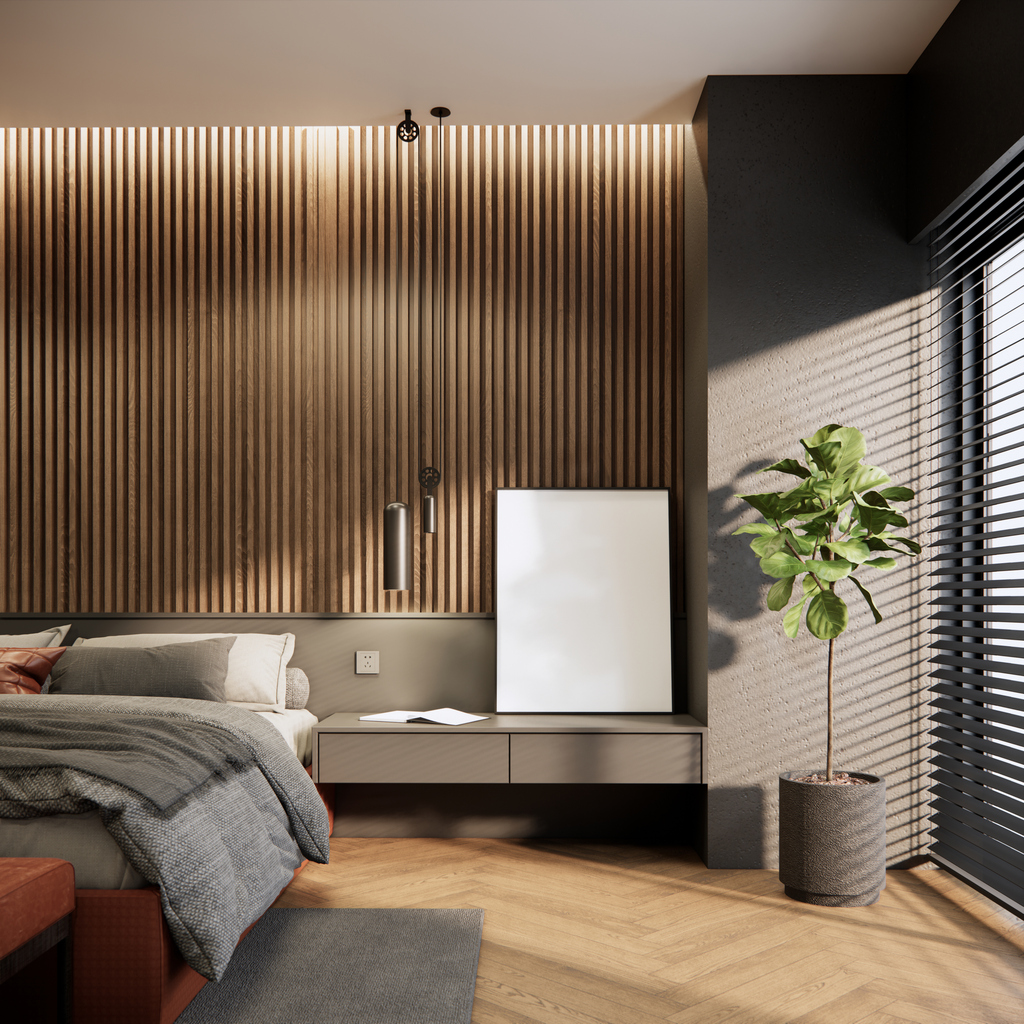Have you ever walked into a Livermore, CA home and were instantly drawn to one beautifully painted wall? That’s the magic of an accent wall. While traditionally, rooms might be painted in one uniform color, this can sometimes feel too monotonous. An accent wall breaks this monotony, and with an accent wall, you can see that adding a splash of color or texture can transform the entire space.
What is an Accent Wall?
An accent wall, simply put, is one wall within a room that’s painted in a different yet complementary color from the others. It adds to the aesthetics of the room, but it does more than that—it serves as a focal point that can tie a room together, making it feel more cohesive and expressive. Usually, when a fixture or piece of furniture serves as the focal point of the room, the accent wall serves as its background. You can also consider options such as faux painting as well for a unique look.
While there is always a dominant color in a room, other colors should always be used to keep it from overwhelming. The walls are often a neutral color, but an accent wall does not have to be neutral. It can be a bright or even patterned wall that helps to add interest and cohesiveness to a variety of colors in a room.
Whether you’re looking to revamp a living room, a bedroom, or even a small hallway, adding an accent wall is a fantastic way to infuse personality and style into your home.
So, let’s dive in and see how you can make your home a more vibrant and inviting with just a little paint!
Choose the Right Wall
Deciding on the perfect wall for your accent can be a game-changer for the look and feel of any room. Here’s how you can make a surefire choice:
- Look for a natural focal point. Every room has a natural center of attention. It could be a large, bright window, a cozy fireplace, or even a piece of artwork. These features make excellent backdrops for your accent wall because they naturally draw the eye. Imagine painting a bold color behind a fireplace – it highlights this architectural feature and adds a warm, inviting ambiance to the room.
- Look for a wall with an uninterrupted surface.If your room doesn’t have an obvious focal point, choose a wall free of windows and doors. A continuous, uninterrupted surface allows the color to stand out more and creates a more striking impact. This is especially effective in smaller spaces like a hallway or a bathroom, where an accent wall can add depth and interest without overwhelming the space.
- Consider room dimensions. An accent wall can dramatically alter the perception of your room’s size and shape. Want to make a long, narrow room feel more balanced? Paint one of the shorter walls at the end in a bold color. This draws the eye across the room, making it feel wider and more proportionate.
Remember, the wall you choose can completely change the room’s dynamic. So, take a moment to envision how different walls might look with a new hue.
Select the Perfect Color
The paint color you choose for your accent wall must complement the rest of the room and make it come together in a stunning way. Here’s how to navigate the palette and find the color that best suits your space and your style:
- Start with color theory.Complementary colors (those directly opposite each other on the color wheel) can create a vibrant look if you want something bold and energetic. For a more harmonious atmosphere, analogous colors (those next to each other on the color wheel) work beautifully by providing a subtle and soothing visual experience. Not sure where to start? Blue and orange are a classic complementary pair, while blues and greens can blend seamlessly for a calm, cohesive look.
- Reflect on your furniture and décor. Take cues from the biggest pieces in your room. Do you have a standout armchair or a beloved piece of art? Pull colors from these items to use on your accent wall. This method ensures that your new wall complements the existing decor and ties the room together. For instance, if you have a cushion or rug with teal accents, a teal wall could enhance these features and bring a cohesive look to your space.
- Consider the mood and function of the room. Colors have a profound effect on mood. A bedroom might call for calming shades like soft blues or gentle greens, promoting relaxation and peace. On the other hand, a kitchen or home office might benefit from brighter colors like yellow or orange, which inspire energy and creativity. Think about what you do most in that room and how you want to feel while you’re there.
- Decide whether to be subtle or bold. Depending on your room’s existing décor and personal style, you might choose a subtle color just a few shades darker than the rest of your walls, or you might go bold with a vibrant, contrasting color. Think about what you want to feel when you enter the room. Is it a serene, calming atmosphere or a dynamic, energizing space?
- Test your colors. Before you commit, test your colors. Paint swatches on the wall or use removable wallpaper samples to see how the color looks throughout the day as natural light changes. This step can save you from potential disappointment and help ensure the color you choose adds to the room’s charm and ambiance.
- Don’t be afraid to experiment. Sometimes, the best choice is the one you least expect. If you’re drawn to a particular color but are hesitant, consider using it on just an accent wall—this can be a great way to introduce a bold or unusual shade without overwhelming your space.
The right color enhances the room’s features and reflects your personality and style. Take your time, have fun with samples, and make your accent wall a statement piece that truly represents you.
Consider alternative techniques and materials
If you want something a little more striking, don’t limit yourself to plain paint. Many creative ways exist to make that wall stand out, using different materials and techniques. Let’s explore some fun alternatives that can add texture, pattern, and a unique flair to your space:
- Wallpaper:Wallpaper is making a huge comeback, and it’s not hard to see why. With endless patterns, textures, and colors to choose from, wallpaper can dramatically change the look of any room. From bold geometric patterns to delicate floral prints, there’s something to fit every taste. Plus, with the advent of peel-and-stick wallpaper, updating your accent wall can be a fun DIY project that’s easy to change if you decide you want a different look later on.
- Textured finishes:If you’re after a more subtle depth, consider textured paint finishes. Techniques like sponging, rag rolling, or even brush texturing can add a tactile quality that plain paint just can’t match. These methods are surprisingly simple to apply but can profoundly affect a room’s ambiance. Imagine a soft, sponged finish in a serene bedroom or a bold, rag-rolled effect in an energetic living room.
- Stripes and patterns:Painting stripes or other patterns can create visual interest and make your accent wall pop. Vertical stripes can make a room feel taller, while horizontal stripes can make it seem broader. Consider using painter’s tape to create geometric patterns or abstract designs for a truly unique look. This can be a playful way to inject personality into your space and make your accent wall a real conversation starter.
- Murals and large-scale art:For those who want to make a dramatic impact, a painted mural or large-scale art piece can be a stunning option. Whether you hire an artist or tackle the project yourself, a mural can tell a story or reflect your passions in a way that nothing else can. This approach works especially well in rooms where you spend a lot of time and want to enjoy a visually captivating scene.
- Wood slat walls: Wood slat walls are a trendy and stylish alternative that is an excellent choice if you’re looking for a contemporary and cozy element in your room. These features involve thin strips of wood that are mounted on a wall in various patterns – usually horizontal. Not only do they bring a touch of nature indoors, but they also add a modern architectural element that can make any wall stand out. Another advantage of this option is that it can alsoenhance acoustics in a room because it can help to reduce echo.
- Combining techniques:Don’t feel you must stick to one method. Mixing and matching different materials and techniques can result in a truly bespoke wall. For example, you could combine a textured base coat with a stenciled design on top or layer peel-and-stick decals over a painted background. The possibilities are only limited by your imagination!
Experimenting with these alternative techniques can elevate the look of your accent wall and make the decor process exciting and deeply personal.
Conclusion
Creating an accent wall is a chance to add some personality and style to your room. If you’re bored with your interiors, perhaps adding an accent wall can create the allure and style you’ve been craving.
However, if you find yourself hesitating at the paint aisle, unsure of which sheen to choose, or if the thought of aligning wallpaper gives you pause, remember that help is just a phone call away. Custom Painting, Inc. is here to assist you with your painting project. With years of experience and a keen eye for detail, our professional painters can help you bring your vision to life with precision and flair. Whether you need advice on color selection or require a full-service painting job, call us at 925-866-9610 or leave a message.



